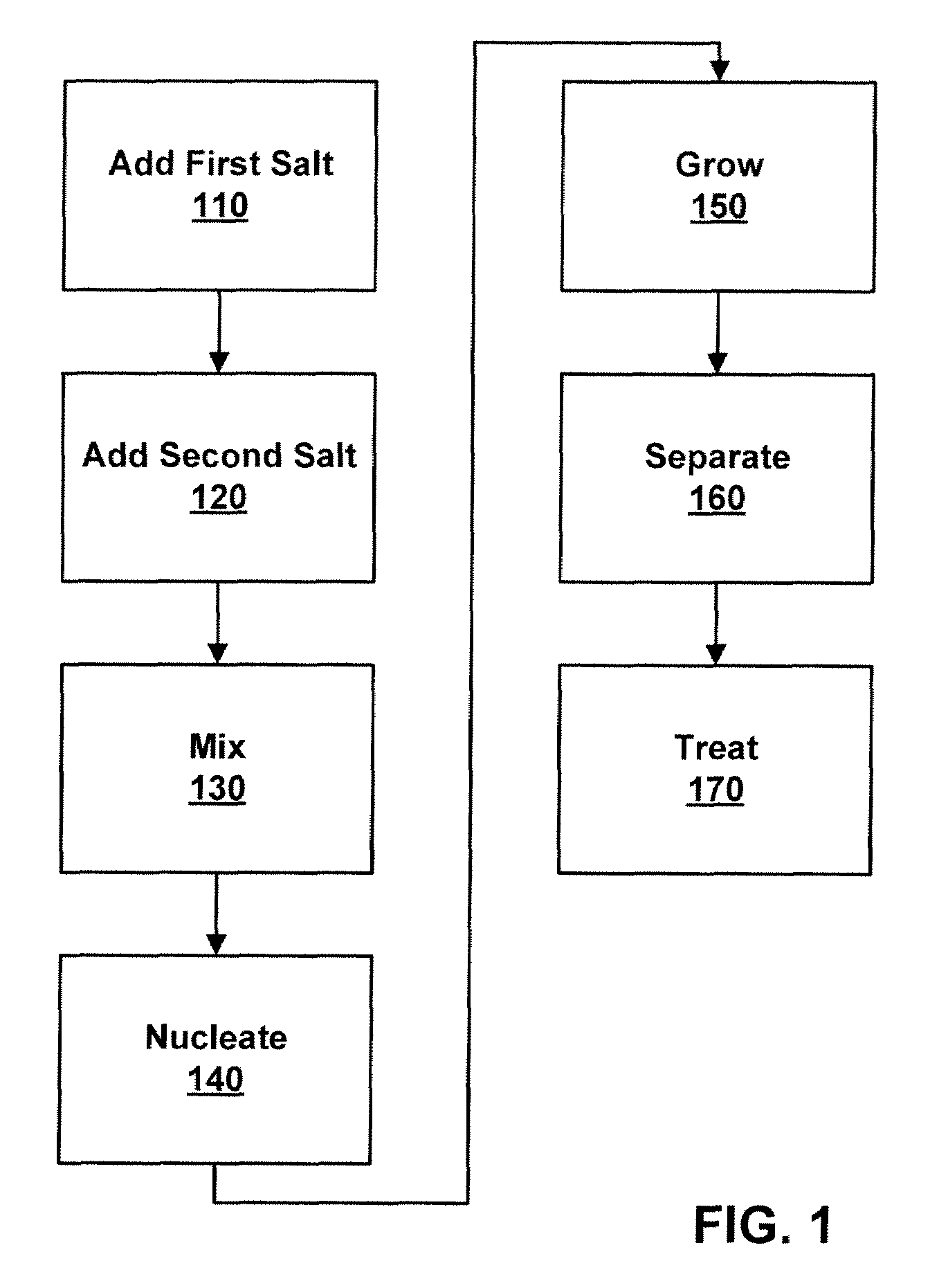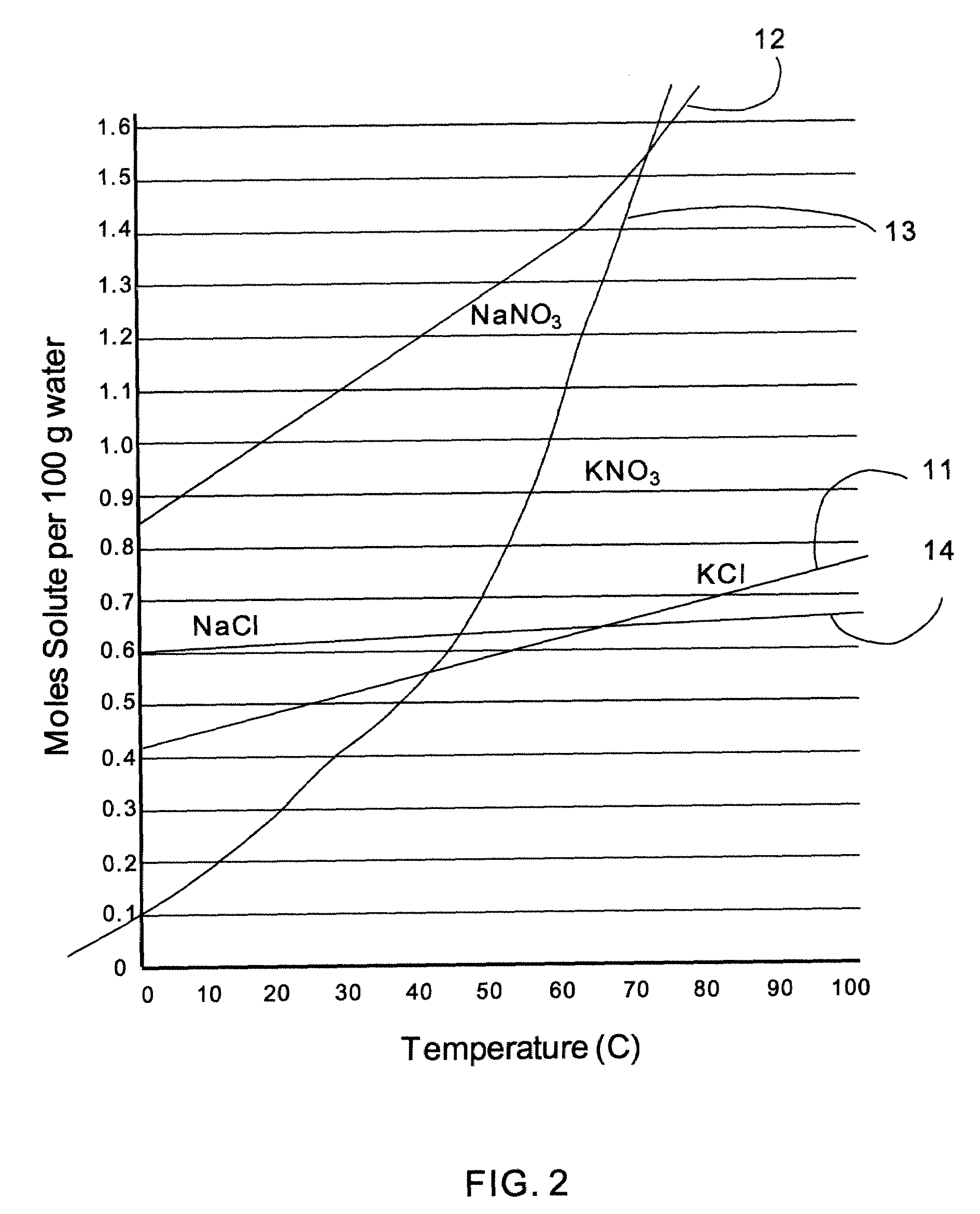Process to form nano-sized materials, the compositions and uses thereof
a nano-sized material and composition technology, applied in the field of compositions to produce nano-sized materials, can solve the problems of pain, no single agent or treatment form is universally effective, and none of the treatments described hereinabove provides a completely satisfactory remedy for pain, so as to prevent tooth decay and sensitivity, improve performance, and improve the effect of penetration through and transpor
- Summary
- Abstract
- Description
- Claims
- Application Information
AI Technical Summary
Benefits of technology
Problems solved by technology
Method used
Image
Examples
example 1
Reaction of KCl and NaNO3
[0051]In this example, the reactants KCl and NaNO3 are used, and the relevant reaction to synthesize KNO3 NPs is:
KCl+NaNO3→KNO3 (Colloidal NPs)+NaCl (2)
[0052]In this case, the reaction is carried out in aqueous conditions since the solubility (moles of solute / 100 g H2O) of KCl, NaNO3, and NaCl in water are all greater than KNO3 through a broad temperature range (less than about 39° C.), as shown in FIG. 2, with curves KCl (11), NaNO3 (12), KNO3 (13) and NaCl (14). With regard to the solubility of the products, KNO3 is less soluble (moles of solute / 100 g H2O) than NaCl over an even broader temperature range (less than about 44° C.). The result of this reaction as described above is the generation of colloidal NPs of KNO3 along with solvated ions. One specific embodiment of this synthesis is the following:
[0053]The reaction is run at 0° C., though it will run at any temperature within the range specified herein, including less than about 45, 40, 35, 30, 25,...
example 2
KNO3 Formation at About 16° C. in Nanoparticle Size
[0054]Some embodiments of this synthetic method for KNO3 NPs include the following:
[0055]The reaction is first run at any temperature above approximately 16° C. For example, between 45 and 16° C. This temperature is T1 ° C. The stoichiometric limiting reactant is again made to be KCl due to its low solubility. An aqueous solution of KCl at temperature T1° C. is made with a concentration of about 0.41 moles of KCl / 100 g or H2O. A stoichiometric equivalent amount of NaNO3 is prepared in a solution with a concentration of about 0.41 moles of NaNO3 / 50 g H2O at T=T1 ° C. A coordinating species or surfactant such as Triton X-100 is added into either the KCl or NaNO3 solution in the amount of roughly one drop per milliliter of solution. With vigorous stirring of the solution with the coordinating species, the other solution is added to the stirred solution, maintaining a temperature of above about 16° C. such as T1 ° C. This creates KNO3 a...
example 3
KNO3 Formation at About 50° C. in Nanoparticle Size
[0056]Some embodiments of this synthetic method include the following: The reaction is first run at a temperature above approximately 50° C. Let this temperature be T1 ° C. An aqueous solution of KCl at temperature T1 ° C. is made with a concentration of about 0.6 moles of KCl / 100 g or H2O. A stoichiometric equivalent amount of NaNO3 is prepared in a solution with a concentration of about 0.6 moles of NaNO3 / 46 g H2O at T=T1 ° C. A coordinating species or surfactant such as Triton X-100 is added into either the KCl or NaNO3 solution in the amount of roughly 1 drop per milliliter of solution. With vigorous stirring of the solution with the coordinating species, the other solution is added to the stirred solution, maintaining a temperature of above about 50° C. such as T1 ° C. This creates KNO3 and NaCl in the effective concentration of 0.41 moles of KNO3 / 100 g H2O and 0.41 moles of NaCl / 100 g H2O. These concentrations are below the sa...
PUM
 Login to View More
Login to View More Abstract
Description
Claims
Application Information
 Login to View More
Login to View More - R&D
- Intellectual Property
- Life Sciences
- Materials
- Tech Scout
- Unparalleled Data Quality
- Higher Quality Content
- 60% Fewer Hallucinations
Browse by: Latest US Patents, China's latest patents, Technical Efficacy Thesaurus, Application Domain, Technology Topic, Popular Technical Reports.
© 2025 PatSnap. All rights reserved.Legal|Privacy policy|Modern Slavery Act Transparency Statement|Sitemap|About US| Contact US: help@patsnap.com


